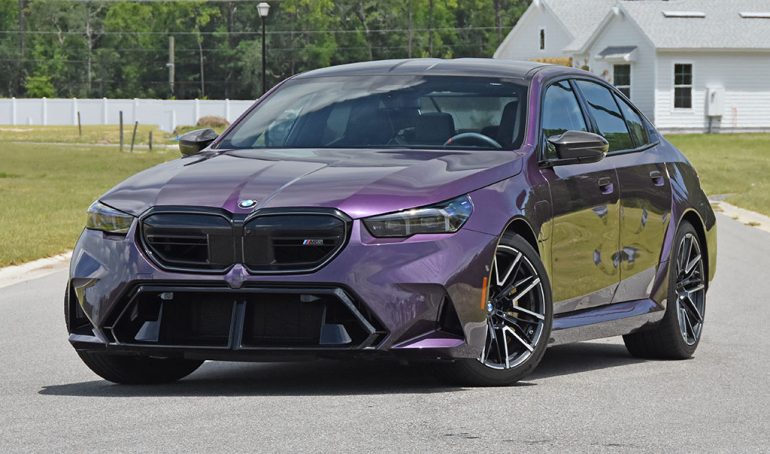
We’ve entered a new dimension when it comes to luxury performance sedans, a realm where BMW has utilized plug-in hybrid electric vehicle (PHEV) technology as a paradigm to add power instead of a primary focus on efficiency. Such a formula isn’t necessarily anything new under the sun, but such a formula is relatively novel for a luxury performance sedan, one that regrettably has a curb weight of nearly 5,400 pounds. However, having experienced the new BMW M5 in its full glory and living with it every day for a week, that extra heft isn’t necessarily a problem – it’s just a hidden thing that’s the result of being such a bubbly vehicle packed full of tech, luxury, and an adornment of performance goodies giving you over 700 horsepower to play with.
Undoubtedly, the new BMW M5 is an interesting and quite different thing from what I remember in a vehicle that was a definitive benchmark for its segment. The difference in what you find in the M5 isn’t all bad despite all the cars and coffee and social media chatter about its extra weight problem. Just know that this big girl can move and do it in a way that nearly defies the laws of physics. Yes, BMW has pulled off an amazing feat – one that I thought would end in disappointment after my week-long seat time in the heavy luxury performance sedan. I was mistaken!

Touting a total of 717 horsepower and 738 lb-ft of torque as the collective power output from its 4.4-liter twin-turbo V8 engine working with a PHEV setup and its electric motor, which alone is good for 194 horsepower and 207 lb-ft of torque on its own to deliver about 25 miles of electric-only range. There’s an 8-speed automatic transmission that is used with both the gas engine and even during those electric-only drives where BMW cleverly shifts through the gears to maximize the output of the electric motor – which happens to be quite decent to keep up with traffic and acceleration out of the hole. Here, the BMW M5 isn’t as much of a slouch as other PHEVs in its electric-only mode, actually providing a good bit of oomph.

When the all-wheel-drive drivetrain is left to its decisive adventures, there are ‘some’ efficiency benefits to the equation where I walked away getting better than the EPA estimated 14 mpg combined highway/city figure (12 mpg city/17 mpg highway) that this big saloon is given. Such a figure is more representative of you utilizing the sportier drive settings, putting the drivetrain in its most aggressive Sport Plus mode. Such a mode will actually start to charge up the 14.8 kWh PHEV lithium-ion battery, then return the poor gas mileage. Otherwise, you’ll expect to get as much as 23 mpg on the highway as I observed in the Comfort drivetrain setting. You can eventually land the EPA estimated 50 MPGe when you drive off with a full tank of premium unleaded and a fully charged battery that takes just over 2 hours to fully charge using a Level 2 charger (J1772). The cruising range is dismal at 270 miles, using the gas engine without a charge of the PHEV battery, which has just a 15.9-gallon fuel tank.

To get the best of the performance benefits from the M5, you’ll want to program your M1 or M2 steering wheel buttons to enable the Sport Plus modes for many vehicle perimeters, dialing up the overall performance to overcome that weight problem. Doing such, you’ll become wide-eyed at how well the M5 then performs – virtually hiding its extra heft but at the expense of a somewhat choppy and rough ride quality that tends to loft around in the rear when you have the chassis/adaptive dampers set in their Comfort mode. From there, the Sport and Sport Plus modes for the chassis firm things up nicely but not to the point of being overly jarring. Still, BMW seems to falter with the rear suspension’s loftiness going over road undulations and rises to the point that rear passengers come out of their seats at times.

Apart from the suspension shortcoming, the BMW M5 is an outright gangster or much like a bully as it has a large dominating presence with its bubbly looks and thrashing performance. That performance starts from the very onset of pressing the throttle, where there’s instant torque that launches the vehicle, much like how a performance electric vehicle (EV) would. There’s no hesitation, no lag, no delay – it just goes with authority and maybe some front wheel spin at times. There’s almost no need to utilize the launch control as stomping the throttle is nearly as aggressive as using launch mode. When using launch mode, I was able to get the best 0-60 mph speed of 2.9 seconds. Sure, that’s quick, but just a hair or two shy of the outgoing M5 generation. Regardless, there’s much more substance down low for usable power, and the midrange is pulled like a nitrous-injected freight train – if you can imagine such a thing. A two-wheel-drive mode allows you to have even more fun lighting up the rear tires, and then you really feel that weight start to rear its ugly head when you attempt to drift this big and powerful machine.

It’s odd to find a PHEV doing the things that the new M5 does, but many have done it before in the hypercar realm – remember the McLaren P1 and even the Porsche 918? The only thing is we’re working with a lot more weight that seemingly doesn’t affect much unless you line up the new M5 with an actual hypercar and you start to see where weight matters. Otherwise, the M5 is a wonderful machine on its own merit and eclipses competitors with its PHEV versatility and usability of performance, where the electric motor tends to fill the power-lagging gaps of the turbocharged V8 engine. It works well, and I can’t deny the forward-thinking engineering put into such a complex machine.

Adding to the complexity are the typical methods of setting up the M5 for your desired perimeters for driving modes and settings. It feels like there are hundreds of ways of setting things up! Helping things along in a more simplified method are hidden features like the rear wheel steering to virtually shorten the wheelbase in turns or aid lane-changing maneuverability at highway speeds. The surprisingly sticky Hankook Ventus S1 Evo Z tires hook up well. BMW’s choice of staggering the wheels using smaller 20-inch front (285/40ZR-20 tires) wheels over the 21-inch rears (295/35ZR-21 tires) seems to be odd for aesthetics, in my opinion. Still, it may be a help for performance, as are the carbon ceramic brakes that are necessary for slowing all of the good-looking Daytona Violet Metallic-colored Bavarian heft to a stop.

You have all of the expected luxury appointments sans massaging seats, something that is oddly missing from the options list but was offered on the outgoing M5. However, the front seats happen to be the comfiest seats on any BMW I’ve experienced, with seat ventilation that finally works well to cool your hind parts. On the new BMW 5 Series platform, there’s a welcoming new style for BMW’s midsized sedan that’s only dialed up for its sportiness in the M5. The one unfortunate takeaway from the new interior is the lack of rear legroom, something that you don’t notice until you have someone sit behind you. At over 6 feet tall, it seems the front seats adjust far enough back to eat into the legroom pretty quickly. The technology seems to distract you from that shortcoming as there’s the slightly curved 14.9-inch infotainment touchscreen and the driver’s 12.3-inch digital gauge cluster all combined into a flowing unit that seems to sit on top of the dashboard.

The latest iDrive 8.5 setup works well after overcoming the learning curve that may take some longer than others to master. However, the controls are redundant through the updated iDrive controller and an array of buttons, which are all on the same pressure-sensitive platform. Wireless Apple CarPlay and Android Auto all work well, and streaming videos on the front touchscreen can be permitted when you’re parked. The wireless charging pad seems to be much cooler this time around, and my iPhone 16 Pro Max didn’t overheat as it has in other vehicles when wirelessly charging.

If you ask me, BMW has gone the distance to show off in a way that no one really asked them to do. However, they have everyone talking and later find out that the weight problem of the new M5 may not be as big a deal as initially thought. Still, it’s there, and you’re going to pay for it one way or another – even with your wallet, as my test vehicle has a price of $146,225 after checking just about every option box to quickly add to the base price of $119,500.
FOLLOW US TODAY:

Malcolm Hogan is the founder and editor of Automotive Addicts, a trusted voice in the automotive media world for over two decades. With 20+ years of hands-on experience covering the industry, Malcolm has built a reputation for delivering honest reviews, sharp insights, and in-depth coverage of everything from new car debuts to high-performance test drives. Passionate about the evolving car culture and staying ahead of the curve, Malcolm continues to lead Automotive Addicts as a go-to destination for enthusiasts and industry insiders alike.


